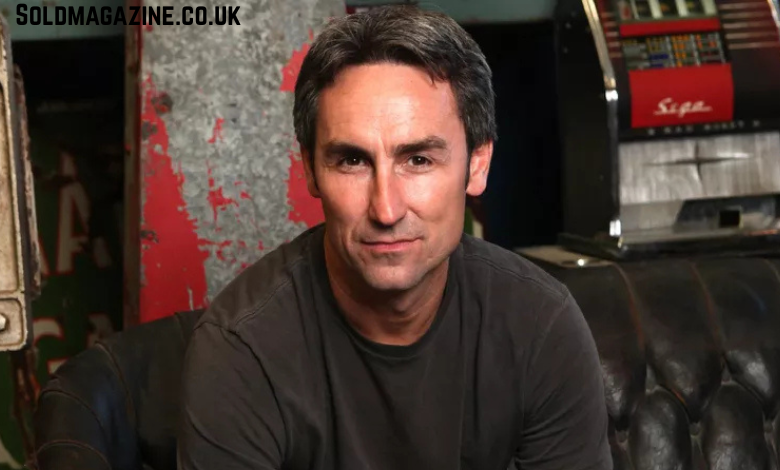Mike Wolfe, best known as the creator and co-host of the long-running television show American Pickers, has made a career out of uncovering forgotten Americana. But beyond the TV spotlight, Wolfe has consistently shown a personal investment in preserving small-town history. His most recent undertaking—a hands-on restoration of a mid-century Esso gas station in downtown Columbia, Tennessee—reflects that same devotion. Unlike a commercial flip or TV-driven makeover, this project is rooted in Wolfe’s lifelong commitment to community, architecture, and American heritage.
This passion project isn’t just a real estate investment or a business opportunity. It represents Wolfe’s approach to history not as nostalgia, but as living culture. With the Columbia Esso station, he continues a pattern of using his influence and resources to bring visibility and purpose to overlooked pieces of the American landscape.
The Columbia Esso Station: A Landmark Reimagined
The centerpiece of Wolfe’s current efforts is a derelict Esso gas station located in the heart of downtown Columbia. The building, once a fixture of everyday life in the mid-20th century, had long fallen into disrepair. Rather than demolish or modernize the structure beyond recognition, Wolfe opted for a sensitive restoration. His aim was to preserve the identity of the station while giving it a new function as a community space.
In a May 28 post on Instagram, Wolfe shared the progress of the project with his followers, noting:
“When I bought the old Esso station in downtown Columbia, Tennessee, I knew I needed a team that shared my vision to help revive its spirit.”
Though the visual reveal impressed fans, the intention behind the work struck a deeper chord. Wolfe didn’t just want to restore a building—he wanted to restore its purpose in the town’s collective memory.
From Forgotten Shell to Functional Space
The restoration involved both architectural preservation and functional redesign. Wolfe and his team didn’t merely patch up the exterior; they made sure that the character of the building—the lines, signage, materials, and layout—was respected. The curved lines and enamel panels of the original Esso structure were polished up. Historic signage was retained or faithfully recreated. Inside, the space was converted into a multi-purpose venue.
Wolfe envisions the renovated station as more than a museum piece. It’s now a functioning space that hosts community events, local pop-ups, and collaborative projects. While he hasn’t publicly announced a fixed list of activities for the building, the space has already been used for gatherings that draw in Columbia residents and tourists alike.
This approach blends preservation with reinvention. By offering the space back to the community in a new form, Wolfe ensures the building will remain alive, not just admired from the outside.
Why Columbia, Tennessee?
Wolfe’s choice of Columbia, Tennessee, for this project is not random. The town, located about 45 miles south of Nashville, has emerged as a vibrant regional hub with a growing interest in local history and preservation. Wolfe has been active in Columbia’s development and has previously spoken about its appeal—the downtown charm, the friendliness of the residents, and its untapped historical value.
For Wolfe, Columbia represents the kind of place that can serve as a national model for what he calls “Main Street revitalization.” These are towns that once thrived around small businesses, gas stations, and roadside Americana, and Wolfe believes they can thrive again—with the right attention and investment.
His presence in Columbia is part of a broader trend of creatives and entrepreneurs choosing to build in smaller towns rather than big cities. Wolfe’s project is both a reflection of and a contribution to Columbia’s resurgence.
How It Fits into Wolfe’s Broader Vision
This is not Wolfe’s first restoration or community-driven initiative. His Antique Archaeology stores in Le Claire, Iowa, and Nashville, Tennessee, have long served as more than retail shops—they’re curated spaces celebrating American craftsmanship and storytelling.
However, Wolfe recently closed the Nashville location, raising questions about where he would focus his energy next. The Columbia project offers an answer: a deeper engagement with place, history, and public use.
In parallel, Wolfe has teased several new ventures. He’s developing a new show for the History Channel, exploring stories and themes that go beyond the format of American Pickers. He’s also announced a film project and another business in Le Claire. Taken together, these moves suggest Wolfe is widening his reach while staying rooted in his passion for American history.
Not Just a Renovation, But a Cultural Signal
The Columbia Esso station isn’t just a one-off project. For Wolfe, it’s a symbol of a broader movement he hopes to support—one where neglected buildings are reimagined, not erased. In various interviews and posts, he has emphasized the importance of cultural stewardship, especially in rural and small-town America.
Wolfe’s style of preservation avoids grandiosity. He doesn’t present himself as a savior of towns or buildings. Instead, he works to amplify what already exists, believing that the value is inherent—it just needs the right frame.
By using his personal brand and resources to draw attention to projects like this, Wolfe hopes to inspire others with similar interests. He’s encouraged fellow collectors, builders, and history lovers to take on similar work in their own towns.
The Role of Social Media in Promoting the Project
Wolfe has leveraged Instagram and other platforms to share updates on the project, post behind-the-scenes photos, and offer insight into the restoration process. This transparency has helped demystify what preservation work looks like. For younger audiences especially, seeing the step-by-step transformation of a space can make historical restoration feel tangible.
The public feedback has been overwhelmingly positive. Followers have praised the aesthetics of the restored building, but also the values it represents—local commitment, historical care, and creative reuse.
Social media has also allowed Wolfe to connect with like-minded partners. From local artisans to preservation consultants, many have contributed to the Esso station project after connecting with Wolfe through his posts.
Challenges and Considerations
Restoring a historical building is rarely straightforward. Wolfe and his team had to navigate zoning regulations, material sourcing, and structural updates. Keeping a balance between modern safety standards and historical authenticity is often one of the biggest hurdles in such projects.
In the case of the Esso station, the building likely required upgrades to wiring, plumbing, and insulation. Yet Wolfe was careful to ensure these changes didn’t disrupt the visual and structural integrity of the original architecture.
Another challenge was managing expectations—both his own and the public’s. With a high-profile project shared online, there’s pressure to make it “perfect.” But Wolfe’s goal wasn’t perfection—it was purpose and preservation.
Looking Ahead: What’s Next for Wolfe?
As Wolfe continues to explore new projects, both creative and entrepreneurial, the Columbia Esso station stands as a statement of intent. It encapsulates the direction he’s taking in his post-American Pickers career: more community-based, more personal, and more hands-on.
His film and television plans seem to revolve around similar themes: Americana, storytelling, and place. And his interest in Le Claire, Iowa—home to his original Antique Archaeology store—suggests he will continue investing in towns with rich histories and room to grow.
While there is no indication that Wolfe is stepping away from television, his passion projects show that his legacy will go beyond what’s aired on the History Channel.
Conclusion
Mike Wolfe’s restoration of the old Esso station in Columbia, Tennessee, is more than a building upgrade—it’s a practical example of how individuals can breathe new life into historic spaces. Through careful restoration, community collaboration, and an eye for detail, Wolfe has turned a forgotten gas station into a symbol of local pride and functional renewal.
It also underscores a larger message that Wolfe continues to advocate: history is not just something we study—it’s something we live with and shape. His passion project in Columbia illustrates how preserving the past can build bridges to the future, one building at a time.




